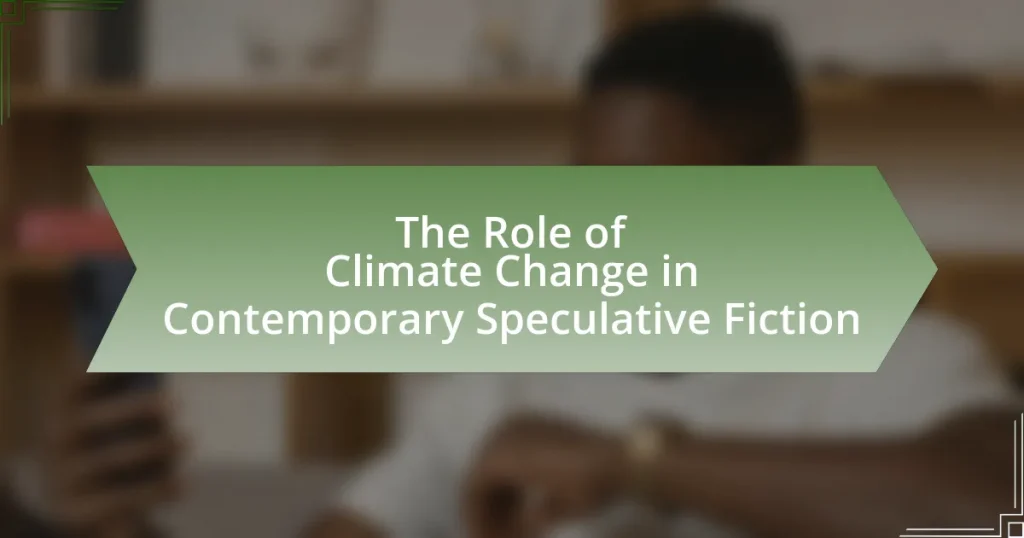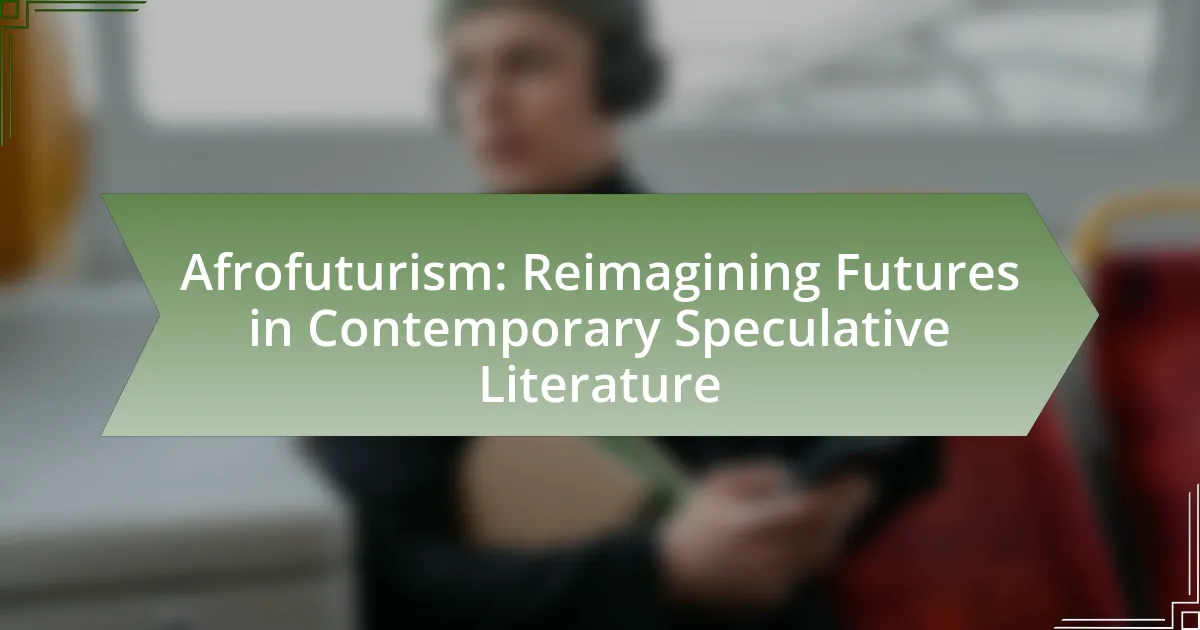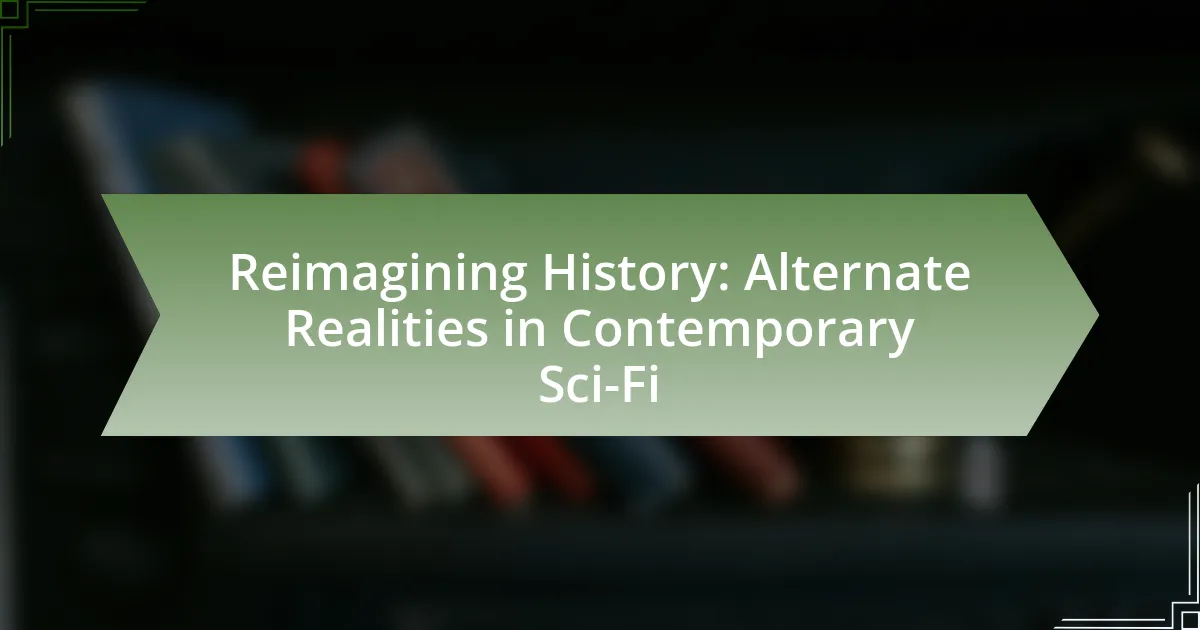The article examines the significant role of climate change in contemporary speculative fiction, highlighting how this genre reflects societal anxieties and explores themes of survival, adaptation, and ethical dilemmas stemming from environmental degradation. It discusses various narratives, such as Kim Stanley Robinson’s “New York 2140” and Margaret Atwood’s “Oryx and Crake,” which illustrate the consequences of climate change and provoke critical discussions about real-world issues. Additionally, the article analyzes how different genres, including science fiction and dystopian fiction, portray climate-related scenarios, emphasizing the emotional responses they evoke in readers and the potential for inspiring action against climate change.
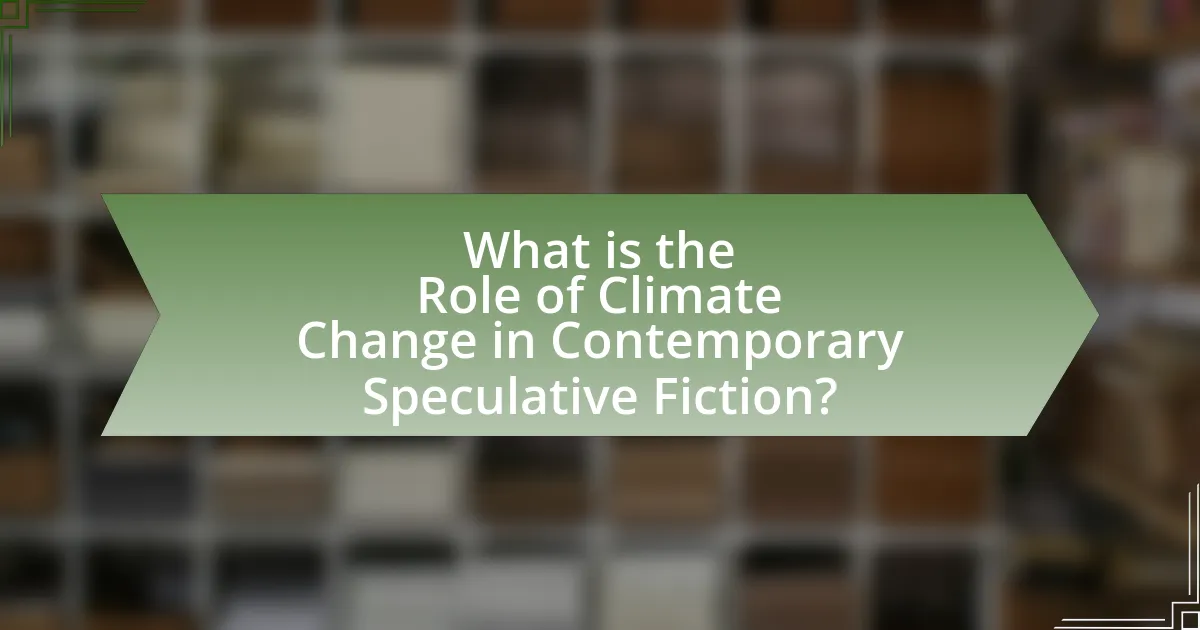
What is the Role of Climate Change in Contemporary Speculative Fiction?
Climate change serves as a critical backdrop in contemporary speculative fiction, often reflecting societal anxieties and potential futures shaped by environmental degradation. This genre utilizes climate change to explore themes of survival, adaptation, and the moral implications of human actions on the planet. For instance, works like Kim Stanley Robinson’s “New York 2140” depict a submerged New York City, illustrating the consequences of rising sea levels and prompting readers to consider the realities of climate-induced displacement. Additionally, Margaret Atwood’s “Oryx and Crake” presents a dystopian world where genetic engineering and ecological collapse intertwine, emphasizing the ethical dilemmas posed by technological advancements in the face of climate crises. These narratives not only entertain but also serve as cautionary tales, urging audiences to confront the urgent realities of climate change and its far-reaching impacts on humanity and the environment.
How does climate change influence the themes in speculative fiction?
Climate change significantly influences the themes in speculative fiction by serving as a backdrop for exploring human resilience, societal collapse, and ethical dilemmas. This genre often reflects the anxieties surrounding environmental degradation, prompting narratives that examine the consequences of climate inaction, such as resource scarcity and mass migration. For instance, works like “The Water Knife” by Paolo Bacigalupi illustrate a future ravaged by water shortages, highlighting the social and political ramifications of climate change. Additionally, speculative fiction frequently addresses themes of adaptation and survival, as seen in “The Overstory” by Richard Powers, which emphasizes the interconnectedness of humanity and nature. These narratives not only entertain but also provoke critical discussions about our current trajectory regarding climate issues, making them relevant and impactful in contemporary discourse.
What specific climate-related issues are commonly explored in these narratives?
Commonly explored climate-related issues in contemporary speculative fiction narratives include climate change impacts, such as extreme weather events, rising sea levels, and biodiversity loss. These narratives often depict scenarios of ecological collapse, resource scarcity, and societal upheaval resulting from environmental degradation. For instance, the novel “The Overstory” by Richard Powers illustrates the interconnectedness of human lives and nature, emphasizing deforestation and its consequences on ecosystems. Additionally, works like “New York 2140” by Kim Stanley Robinson explore the implications of rising sea levels on urban environments, showcasing the adaptation challenges faced by society. These themes reflect real-world scientific concerns, as reported by the Intergovernmental Panel on Climate Change, which highlights the urgency of addressing climate-related issues to mitigate future risks.
How do authors use climate change to reflect societal concerns?
Authors use climate change as a narrative device to highlight societal concerns such as environmental degradation, social inequality, and political inaction. By depicting dystopian futures or altered realities where climate change has severe consequences, authors illustrate the urgency of addressing these issues. For instance, in works like “The Overstory” by Richard Powers, the interconnectedness of human lives and nature emphasizes the impact of deforestation and climate change on biodiversity and human existence. This reflection serves to provoke thought and inspire action among readers regarding real-world environmental challenges.
Why is climate change a significant topic in contemporary literature?
Climate change is a significant topic in contemporary literature because it reflects urgent global concerns and influences societal narratives. Contemporary authors utilize climate change as a backdrop to explore themes of survival, morality, and human resilience, often depicting dystopian futures shaped by environmental degradation. For instance, works like “The Overstory” by Richard Powers and “New York 2140” by Kim Stanley Robinson illustrate the profound impacts of climate change on ecosystems and human societies, prompting readers to engage with the realities of ecological crises. This literary focus not only raises awareness but also encourages critical discourse on environmental issues, making climate change a pivotal element in modern storytelling.
What historical context has led to the rise of climate change narratives?
The rise of climate change narratives is primarily rooted in the industrial revolution, which marked a significant increase in greenhouse gas emissions due to fossil fuel consumption. This historical context is further compounded by scientific advancements in the late 20th century, particularly the 1970s, when researchers like James Hansen began to publicly warn about the consequences of climate change, leading to increased awareness and concern. The establishment of the Intergovernmental Panel on Climate Change (IPCC) in 1988 provided a formal platform for assessing climate science, solidifying the urgency of the issue. Additionally, extreme weather events and natural disasters in recent decades have heightened public consciousness and prompted a cultural shift towards narratives that explore the implications of climate change in speculative fiction, reflecting societal fears and aspirations regarding environmental futures.
How do readers respond to climate change themes in speculative fiction?
Readers often respond to climate change themes in speculative fiction with a mix of concern, engagement, and a call to action. This response is driven by the emotional and imaginative power of speculative narratives that illustrate potential futures shaped by climate change. Research indicates that such narratives can evoke strong emotional reactions, prompting readers to reflect on real-world environmental issues. For instance, a study published in “Environmental Communication” by authors like M. J. M. H. van der Linden found that engaging with climate-themed fiction can increase awareness and motivate behavioral change regarding environmental practices. Thus, readers’ responses are not only emotional but can also translate into a greater commitment to addressing climate change in their own lives.
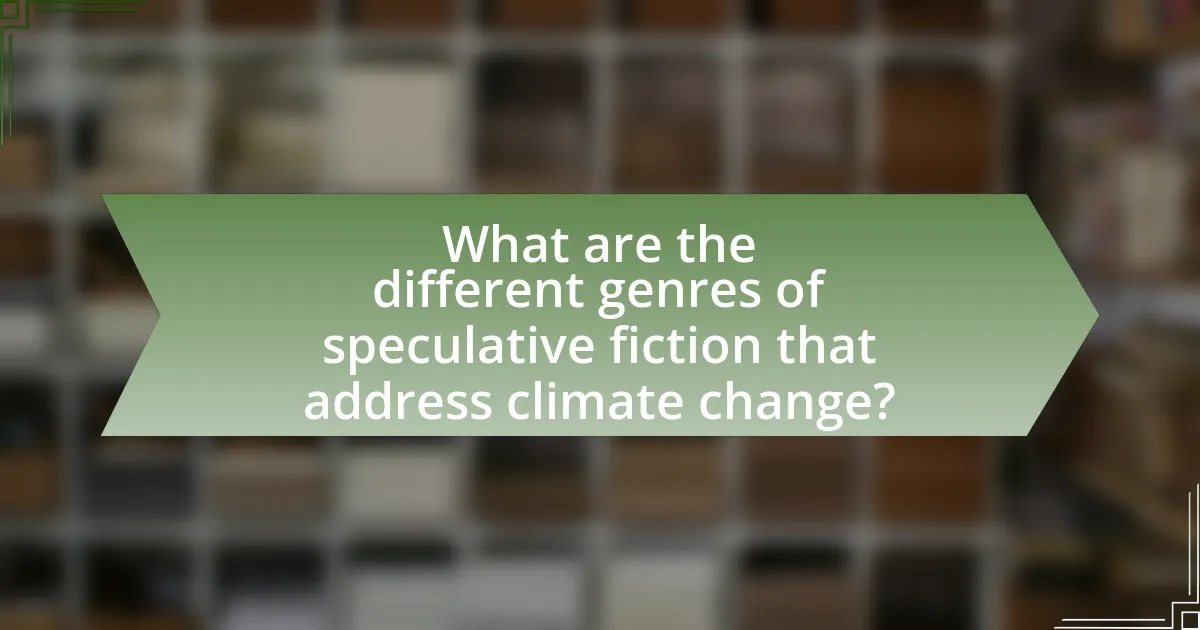
What are the different genres of speculative fiction that address climate change?
The different genres of speculative fiction that address climate change include science fiction, climate fiction (cli-fi), dystopian fiction, and utopian fiction. Science fiction often explores futuristic scenarios influenced by climate change, such as altered ecosystems and advanced technologies for adaptation. Climate fiction specifically focuses on narratives that highlight the impacts of climate change on society and the environment, aiming to raise awareness and provoke thought. Dystopian fiction presents bleak futures resulting from climate disasters, illustrating the consequences of inaction. Conversely, utopian fiction envisions ideal societies that successfully navigate climate challenges, offering hope and potential solutions. These genres collectively reflect the urgency of climate issues and engage readers in critical discussions about the future.
How do science fiction and fantasy uniquely portray climate change?
Science fiction and fantasy uniquely portray climate change by using imaginative settings and speculative scenarios to explore its consequences and human responses. These genres often depict dystopian futures where environmental collapse leads to societal upheaval, as seen in works like “The Water Knife” by Paolo Bacigalupi, which illustrates a world ravaged by water scarcity due to climate change. Additionally, fantasy narratives may incorporate magical elements to symbolize the struggle against ecological destruction, such as in “The Broken Earth” trilogy by N.K. Jemisin, where geological forces reflect the impact of climate change on civilization. These portrayals serve to highlight the urgency of climate issues and provoke critical reflection on humanity’s relationship with nature.
What are notable examples of climate change in science fiction?
Notable examples of climate change in science fiction include “The Windup Girl” by Paolo Bacigalupi, which depicts a future Thailand grappling with rising sea levels and bioengineered food shortages, and “New York 2140” by Kim Stanley Robinson, where the city is partially submerged due to climate change. These works illustrate the consequences of environmental degradation and societal adaptation. Bacigalupi’s narrative highlights the impact of corporate greed on ecological systems, while Robinson’s novel explores urban life in a flooded world, emphasizing resilience and innovation in the face of climate challenges.
How does fantasy use climate change as a metaphor?
Fantasy uses climate change as a metaphor to explore the consequences of human actions on the environment and society. This genre often depicts altered worlds where ecological disasters serve as a backdrop for character development and moral dilemmas, illustrating the fragility of nature and the interconnectedness of all life. For instance, in works like “The Broken Earth” trilogy by N.K. Jemisin, the catastrophic climate events reflect societal issues such as oppression and inequality, emphasizing the need for collective responsibility and action. Such narratives not only entertain but also provoke critical reflection on real-world environmental challenges, making the metaphor of climate change a powerful tool for social commentary.
What role does dystopian fiction play in discussing climate change?
Dystopian fiction serves as a critical lens for examining the consequences of climate change by illustrating potential futures shaped by environmental degradation. This genre often portrays societies grappling with the fallout of ecological disasters, highlighting themes of survival, social inequality, and governmental failure in the face of climate crises. For instance, works like “The Road” by Cormac McCarthy depict a bleak world ravaged by climate-related catastrophes, prompting readers to reflect on current environmental policies and behaviors. Such narratives not only engage audiences emotionally but also stimulate discourse on the urgency of addressing climate change, making the abstract consequences more tangible and immediate.
How do dystopian narratives reflect fears about the future of the planet?
Dystopian narratives reflect fears about the future of the planet by depicting scenarios where environmental degradation leads to societal collapse. These narratives often illustrate the consequences of climate change, such as extreme weather events, resource scarcity, and loss of biodiversity, which serve as cautionary tales. For instance, in works like “The Road” by Cormac McCarthy, the bleak landscape and survival struggles highlight the potential outcomes of neglecting environmental issues. Additionally, the film “Snowpiercer” portrays a world frozen due to climate change, emphasizing the drastic measures humanity may face. Such representations resonate with real-world scientific warnings, such as those from the Intergovernmental Panel on Climate Change, which predict severe impacts if current trends continue. Thus, dystopian fiction serves as a reflection of societal anxieties regarding ecological futures and the urgent need for action.
What are key works in dystopian fiction that focus on climate change?
Key works in dystopian fiction that focus on climate change include “The Water Knife” by Paolo Bacigalupi, “New York 2140” by Kim Stanley Robinson, and “The Overstory” by Richard Powers. “The Water Knife” explores a future ravaged by water scarcity due to climate change, highlighting the socio-political ramifications of resource depletion. “New York 2140” envisions a submerged New York City as a result of rising sea levels, examining the adaptation of society in a transformed environment. “The Overstory” interweaves multiple narratives to illustrate the impact of climate change on ecosystems and humanity’s relationship with nature. These works collectively underscore the urgent themes of environmental degradation and its consequences on civilization.
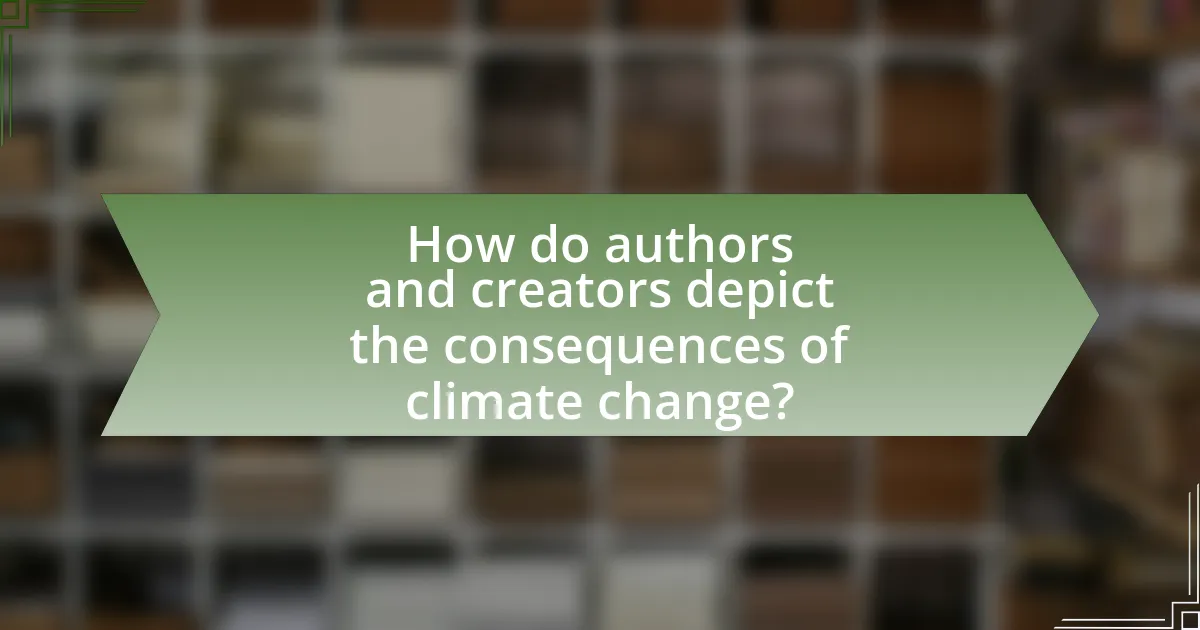
How do authors and creators depict the consequences of climate change?
Authors and creators depict the consequences of climate change through vivid imagery and narrative techniques that illustrate environmental degradation, social upheaval, and human suffering. For instance, in works like “The Overstory” by Richard Powers, the interconnectedness of human lives and nature is emphasized, showcasing how deforestation leads to loss of biodiversity and impacts communities. Similarly, in the film “Interstellar,” the portrayal of a dying Earth due to climate-related disasters highlights the urgency of finding new habitable worlds, reflecting real-world concerns about resource scarcity and survival. These depictions serve to raise awareness and provoke thought about the potential future scenarios resulting from climate change, effectively engaging audiences with the pressing realities of environmental issues.
What are the common scenarios presented in speculative fiction regarding climate change?
Common scenarios presented in speculative fiction regarding climate change include dystopian futures characterized by extreme weather events, societal collapse, and resource scarcity. These narratives often depict a world where rising sea levels have submerged coastal cities, leading to mass migrations and conflicts over habitable land. Additionally, speculative fiction frequently explores themes of ecological disaster, such as widespread species extinction and the breakdown of ecosystems, highlighting the consequences of human negligence. Works like “The Water Knife” by Paolo Bacigalupi illustrate the struggle for water in a parched landscape, while “The Overstory” by Richard Powers emphasizes the interconnectedness of human and natural systems, showcasing the impact of climate change on both. These scenarios serve as cautionary tales, reflecting real-world scientific predictions about the future of our planet if current trends continue.
How do these scenarios impact character development and plot progression?
Scenarios involving climate change significantly impact character development and plot progression by forcing characters to confront moral dilemmas and adapt to rapidly changing environments. For instance, characters may evolve through their responses to environmental crises, showcasing resilience or moral decay, which directly influences their relationships and decisions. In contemporary speculative fiction, narratives often depict characters grappling with the consequences of climate change, such as resource scarcity or societal collapse, which drives the plot forward by creating conflict and urgency. This dynamic illustrates how external pressures shape internal growth, as seen in works like “The Overstory” by Richard Powers, where interconnected stories highlight individual transformations in response to ecological challenges.
What emotional responses do these scenarios evoke in readers?
The scenarios in contemporary speculative fiction that address climate change evoke a range of emotional responses in readers, including anxiety, fear, hope, and urgency. These emotions arise as readers confront the stark realities of environmental degradation and its potential consequences, which are often depicted through vivid and alarming narratives. For instance, studies show that literature highlighting climate disasters can lead to increased feelings of helplessness and concern for the future, as evidenced by research from the University of California, which found that exposure to climate-related themes in fiction can significantly heighten emotional engagement and awareness about real-world issues. This emotional engagement often motivates readers to reflect on their own actions and the broader societal implications of climate change.
How can speculative fiction inspire action against climate change?
Speculative fiction can inspire action against climate change by presenting imaginative scenarios that highlight the potential consequences of environmental neglect. Through narratives that explore dystopian futures or utopian solutions, speculative fiction engages readers emotionally and intellectually, prompting them to consider the urgency of climate action. For instance, works like “The Overstory” by Richard Powers illustrate the interconnectedness of human and ecological systems, encouraging readers to reflect on their own impact on the environment. Additionally, speculative fiction often showcases innovative technologies and social structures that could mitigate climate change, thereby inspiring real-world solutions and activism. By fostering empathy and awareness, speculative fiction serves as a catalyst for change, motivating individuals and communities to take action against climate change.
What messages do authors convey about environmental responsibility?
Authors convey messages about environmental responsibility by highlighting the urgent need for sustainable practices and the consequences of neglecting ecological balance. In contemporary speculative fiction, narratives often depict dystopian futures resulting from environmental degradation, illustrating the potential outcomes of human actions on the planet. For instance, works like “The Overstory” by Richard Powers emphasize interconnectedness among species and the importance of preserving natural ecosystems. These narratives serve as cautionary tales, urging readers to recognize their role in combating climate change and advocating for proactive measures to protect the environment.
How can readers apply insights from speculative fiction to real-world issues?
Readers can apply insights from speculative fiction to real-world issues by using the genre as a lens to explore potential futures and the consequences of current actions, particularly regarding climate change. Speculative fiction often presents scenarios that highlight the impact of environmental degradation, prompting readers to reflect on their own behaviors and societal structures. For example, works like “The Overstory” by Richard Powers illustrate the interconnectedness of human and ecological systems, encouraging readers to consider the importance of biodiversity and conservation efforts. This reflective process can lead to increased awareness and advocacy for sustainable practices, as evidenced by studies showing that literature can influence environmental attitudes and behaviors.
What are some best practices for engaging with climate change themes in speculative fiction?
To effectively engage with climate change themes in speculative fiction, authors should prioritize scientific accuracy, incorporate diverse perspectives, and explore both the socio-political implications and personal impacts of climate change. Scientific accuracy ensures that the narrative is grounded in real-world phenomena, which can enhance credibility and resonate with readers. Incorporating diverse perspectives, including voices from marginalized communities disproportionately affected by climate change, enriches the narrative and fosters empathy. Exploring socio-political implications allows authors to address systemic issues and potential solutions, while personal impacts can humanize the abstract concept of climate change, making it relatable. These practices are supported by the growing body of literature that emphasizes the importance of representation and realism in speculative narratives, as seen in works like “The Ministry for the Future” by Kim Stanley Robinson, which effectively combines scientific principles with social commentary.
